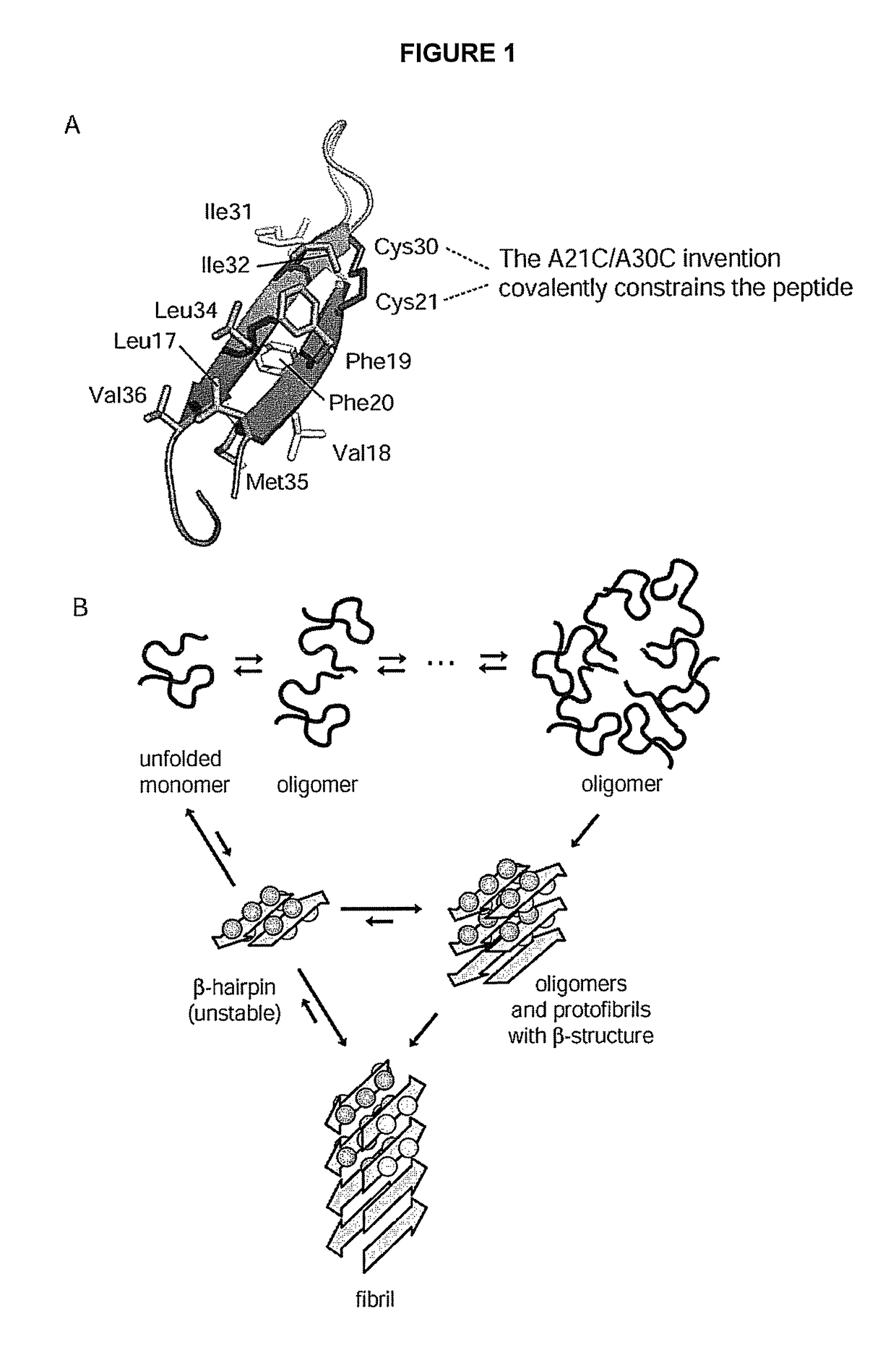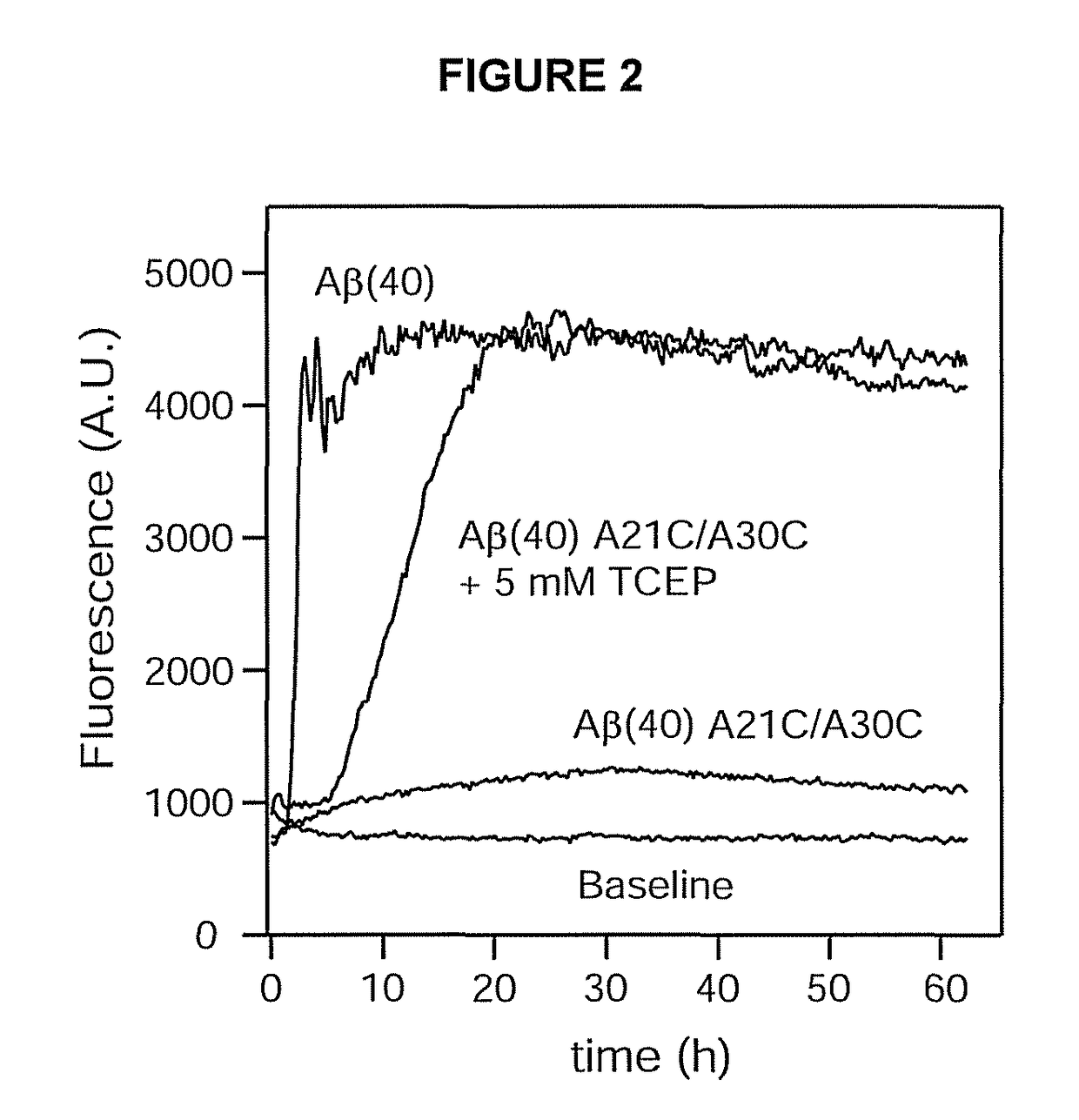Stable amyloid beta monomers and oligomers
a monomer and amyloid beta technology, applied in the field of monomer and oligomer amyloid beta peptides, can solve the problems of ineffective treatment of ad and most the inability to effectively treat ad and other protein misfolding diseases, and the inability to achieve fibrillogenesis seriously limit the longevity of oligomeric preparations, so as to avoid unpredictable outcomes of oligomeric preparations, prolong the incubation time, avoid unpredictable outcome of oligo
- Summary
- Abstract
- Description
- Claims
- Application Information
AI Technical Summary
Benefits of technology
Problems solved by technology
Method used
Image
Examples
example 1
ion Assay of Wild-Type Aβ(40) and Aβ(40) A21C / A30C
[0079]All concentration determinations were carried out spectrophotometrically using an extinction coefficient of 1424 cm−1 M−1 for the difference in absorption at 280 nm and 300 nm. The buffered solution used in all examples was 50 mM K+ phosphate, 50 mM NaCl, pH 7.2, unless otherwise stated. This buffer was also the storage buffer for the Aβ peptides. All peptide samples were prepared fresh, kept at 4° C., and used within 3-4 days.
[0080]Fibrillation assays were carried out by monitoring the enhanced fluorescence of the dye TFT upon binding to the fibrils (Levine, H., Methods Enzymol. 309: 274-284 (1999)). Fluorescence was recorded in 96-well plates (Nunc) using a FLUOstar Optima reader (BMG) equipped with 440 nm excitation and 480 nm emission filters. The peptide samples were kept at 30 μM and were supplemented with 10 μM TFT. In addition, 5 mM TCEP was added to one reference sample of the invention to assay the effect of the forme...
example 2
ion Assays of Aβ(40) A21C / A30C at Increasing Concentrations
[0082]The fibrillation assay was carried out as in example 1, except that the concentration of peptide was also assayed at 50, 150, and 250 μM, and the TCEP concentration was increased to 10 mM TCEP in the reference samples. Also, data points were recorded every 15 min with 5 min of orbital shaking (width 5 mm) preceding each measurement. Dual samples were analyzed at each concentration, and the result is presented in FIG. 3.
[0083]The result is similar to the result obtained in Example 1. However, there is a rapid increase in fluorescence for the samples with an intact disulphide bond at the 150 and 250 μM concentrations, which then decline to similar levels with much slower rates. As demonstrated in Examples 7 and 8 below, the coil-like oligomers can be made to form protofibrillar-like structures when subjected to elevated temperatures, and these do bind TFT weakly thus giving rise to enhanced fluorescence. As time progress...
example 3
-Like Structure of Aβ(40) A21C / A30C
[0085]SEC was carried out on a Superdex 75 10 / 300 column (GE Healthcare) equilibrated with 50 mM K+ phosphate, 50 mM NaCl, pH 7.2. The flow rate was 0.8 ml min−1, and the column was operated by an ÄKTA Explorer unit (GE Healthcare). All column runs were carried out at room temperature (21° C.). The column was calibrated with a low molecular-weight gel filtration calibration kit (Amersham Biosciences) under similar conditions. Typically, 500 μl of peptide was injected into this column during each run.
[0086]At low concentrations of peptide, e.g. 25 μM, the Aβ(40) A21C / A30C peptide typically elutes as an approximately 8-10 kDa protein. Even though the Aβ peptide is approximately a 4.5 kDa protein, we do not interpret this as this peptide is eluting as a dimer because of the potentially extended structures of unfolded coil-like proteins compared to the well-folded proteins used in the calibration kit (ribonucelase A, chymotrypsinogen A, ovalbumin, and ...
PUM
| Property | Measurement | Unit |
|---|---|---|
| molecular-weight | aaaaa | aaaaa |
| molecular-weight | aaaaa | aaaaa |
| molecular-weight | aaaaa | aaaaa |
Abstract
Description
Claims
Application Information
 Login to View More
Login to View More - R&D
- Intellectual Property
- Life Sciences
- Materials
- Tech Scout
- Unparalleled Data Quality
- Higher Quality Content
- 60% Fewer Hallucinations
Browse by: Latest US Patents, China's latest patents, Technical Efficacy Thesaurus, Application Domain, Technology Topic, Popular Technical Reports.
© 2025 PatSnap. All rights reserved.Legal|Privacy policy|Modern Slavery Act Transparency Statement|Sitemap|About US| Contact US: help@patsnap.com



